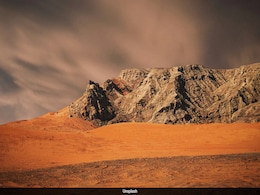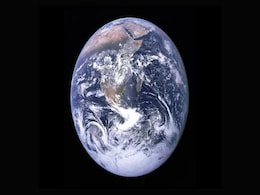Asteroid Belt
- All
- News
-

"Crash Icy Asteroids Into Mars": Scientist's Plan To Make Mars Liveable For Humans
- Wednesday April 9, 2025
- Science | Edited by Nikhil Pandey
Dr Leszek Czechowski proposes a radical approach to terraform Mars by crashing asteroids into the planet.
-
 www.ndtv.com
www.ndtv.com
-

AI Study Finds Organic Molecules on Ceres Likely Came from Asteroid Impacts
- Monday February 3, 2025
- Written by Gadgets 360 Staff
A new AI-driven study has challenged previous assumptions about the origin of organic molecules on Ceres. Scientists have mapped organic-rich areas using data from NASA’s Dawn spacecraft and found no evidence linking these compounds to cryovolcanic activity. Instead, simulations suggest asteroid impacts from the outer belt likely delivered the ma...
-
 www.gadgets360.com
www.gadgets360.com
-

Karnal Students Recognised by NASA for Discovering Main Belt Asteroid TD40
- Monday December 30, 2024
- Written by Gadgets 360 Staff
12 students and two teachers from Dyal Singh Public School in Karnal have been honoured by NASA’s International Astronomical Search Collaboration (IASC) for discovering a main belt asteroid, TD40. The team, under the guidance of Principal Sushma Devgun and Dr Kaveri Chauhan, also registered 11 near-Earth objects. Diksha, a Class XI student, was r...
-
 www.gadgets360.com
www.gadgets360.com
-

James Webb Telescope Spots 138 New Asteroids in the Main Belt, Some Heading Towards Earth
- Tuesday December 17, 2024
- Written by Gadgets 360 Staff
Astronomers have discovered 138 new asteroids in the main asteroid belt between Mars and Jupiter using the James Webb Space Telescope (JWST). These decametre-sized asteroids, some of which are on paths that could bring them close to Earth, were identified through a new computational technique. The discovery enhances our understanding of small space...
-
 www.gadgets360.com
www.gadgets360.com
-

Research Reveals Three Young Asteroid Families as Main Sources of Earth’s Meteorites
- Tuesday October 22, 2024
- Written by Gadgets 360 Staff
A recent study reveals that three asteroid families—the Karin, Koronis, and Massalia—are responsible for around 70% of the meteorites that land on Earth. These families, formed from past collisions in the main asteroid belt, have a higher number of fragments due to their relatively young age. The findings shed light on the origins of meteorites...
-
 www.gadgets360.com
www.gadgets360.com
-

Major Meteorite Discoveries Reveal Origins From Three Asteroid Families
- Friday October 18, 2024
- Written by Gadgets 360 Staff
An international research team has revealed that 70% of known meteorite falls originate from just three young asteroid families: Karin, Koronis, and Massalia. These families were formed by collisions in the main asteroid belt approximately 5.8, 7.5, and 40 million years ago. The Massalia family alone accounts for 37% of meteorites. This significant...
-
 www.gadgets360.com
www.gadgets360.com
-

Dwarf Planet Ceres Once Hosted a Muddy Ocean Below Its Icy Surface
- Tuesday October 8, 2024
- Written by Gadgets 360 Staff
Recent research indicates that Ceres, the largest object in the asteroid belt, likely harboured a muddy ocean beneath its icy crust. Advanced computer simulations suggest that its surface features and gravity measurements point to a past rich in ice. With its proximity to Earth, Ceres presents a promising target for further exploration, making it t...
-
 www.gadgets360.com
www.gadgets360.com
-

Is Earth’s New Minimoon 2024 Visible to Naked Eye? Here's What You Need to Know
- Thursday October 3, 2024
- Written by Gadgets 360 Staff
On Sunday, 29th September, Earth captured a new "minimoon" known as 2024 PT5. The bus-sized asteroid, measuring 33 feet wide, is temporarily orbiting Earth for 57 days. Although it's a fascinating addition, the minimoon is too small to be seen with the naked eye or typical amateur telescopes. Researchers believe the asteroid originated from the Arj...
-
 www.gadgets360.com
www.gadgets360.com
-

Earth's 'Second Moon' To Be Visible Today. All About Asteroid 2024 PT5
- Sunday September 29, 2024
- Science | Edited by Anjali Thakur
The asteroid, named 2024 PT5, originates from the Arjuna asteroid belt, which contains rocks with orbits similar to Earth's.
-
 www.ndtv.com
www.ndtv.com
-

Earth to Capture an Asteroid as Second Moon Temporarily This Weekend, NASA Confirms
- Sunday September 29, 2024
- Written by Gadgets 360 Staff
Earth is set to capture a temporary second moon, asteroid 2024 PT5, starting September 29, 2024. This small asteroid, part of the Arjuna asteroid belt, will only remain in Earth’s orbit until November 25, 2024, before continuing its journey around the sun. Though not visible to the average observer, this rare event has piqued the interest of prof...
-
 www.gadgets360.com
www.gadgets360.com
-

Study Of Craters Suggests Earth Once Had Saturn-Like Rings
- Wednesday September 18, 2024
- Science | Edited by Amit Chaturvedi
The study said that the asteroid belt was formed due to the break-up of an asteroid passing within Earth's Roche limit.
-
 www.ndtv.com
www.ndtv.com
-

Earth Might Gain Another Moon Temporarily as a Small Asteroid Could Begin Orbit It, Claims Study
- Monday September 16, 2024
- Written by Gadgets 360 Staff
Earth might gain another Moon, a miniature one, due to a rare phenomenon called gravitational trapping. Carlos de la Fuente Marcos and Raúl de la Fuente Marcos, researchers from Universidad Complutense de Madrid, have announced an intriguing celestial event. A small asteroid, named 2024 PT5, is set to become Earth's temporary mini-moon for appro...
-
 www.gadgets360.com
www.gadgets360.com
-

Asteroid That Triggered Dinosaur Extinction Was a Carbon-Rich C-Type Space Rock, Study Finds
- Saturday August 17, 2024
- Written by Gadgets 360 Staff
Recent research has provided new insights into the asteroid that struck Earth 66 million years ago, causing a mass extinction event that led to the end of the dinosaurs. Scientists have now identified this impactor as a carbon-rich "C-type" asteroid, a type of space rock that likely originated in the asteroid belt between Mars and Jupiter.
-
 www.gadgets360.com
www.gadgets360.com
-

Mysterious 'Dark Comets' May Pose Bigger Threat Than Previously Thought To Earth
- Thursday July 18, 2024
- Science | Edited by Nikhil Pandey
Scientists have identified a new class of space rocks called "dark comets" that may be harder to detect and pose a greater danger than previously thought.
-
 www.ndtv.com
www.ndtv.com
-

Study Reveals How Earth Acquired Its Water
- Saturday July 13, 2024
- Science | Edited by Nikhil Pandey
Astronomers have discovered "dark comets," enigmatic objects that could account for up to 60% of near-Earth objects and may provide insights into the origins of Earth's water.
-
 www.ndtv.com
www.ndtv.com
-

"Crash Icy Asteroids Into Mars": Scientist's Plan To Make Mars Liveable For Humans
- Wednesday April 9, 2025
- Science | Edited by Nikhil Pandey
Dr Leszek Czechowski proposes a radical approach to terraform Mars by crashing asteroids into the planet.
-
 www.ndtv.com
www.ndtv.com
-

AI Study Finds Organic Molecules on Ceres Likely Came from Asteroid Impacts
- Monday February 3, 2025
- Written by Gadgets 360 Staff
A new AI-driven study has challenged previous assumptions about the origin of organic molecules on Ceres. Scientists have mapped organic-rich areas using data from NASA’s Dawn spacecraft and found no evidence linking these compounds to cryovolcanic activity. Instead, simulations suggest asteroid impacts from the outer belt likely delivered the ma...
-
 www.gadgets360.com
www.gadgets360.com
-

Karnal Students Recognised by NASA for Discovering Main Belt Asteroid TD40
- Monday December 30, 2024
- Written by Gadgets 360 Staff
12 students and two teachers from Dyal Singh Public School in Karnal have been honoured by NASA’s International Astronomical Search Collaboration (IASC) for discovering a main belt asteroid, TD40. The team, under the guidance of Principal Sushma Devgun and Dr Kaveri Chauhan, also registered 11 near-Earth objects. Diksha, a Class XI student, was r...
-
 www.gadgets360.com
www.gadgets360.com
-

James Webb Telescope Spots 138 New Asteroids in the Main Belt, Some Heading Towards Earth
- Tuesday December 17, 2024
- Written by Gadgets 360 Staff
Astronomers have discovered 138 new asteroids in the main asteroid belt between Mars and Jupiter using the James Webb Space Telescope (JWST). These decametre-sized asteroids, some of which are on paths that could bring them close to Earth, were identified through a new computational technique. The discovery enhances our understanding of small space...
-
 www.gadgets360.com
www.gadgets360.com
-

Research Reveals Three Young Asteroid Families as Main Sources of Earth’s Meteorites
- Tuesday October 22, 2024
- Written by Gadgets 360 Staff
A recent study reveals that three asteroid families—the Karin, Koronis, and Massalia—are responsible for around 70% of the meteorites that land on Earth. These families, formed from past collisions in the main asteroid belt, have a higher number of fragments due to their relatively young age. The findings shed light on the origins of meteorites...
-
 www.gadgets360.com
www.gadgets360.com
-

Major Meteorite Discoveries Reveal Origins From Three Asteroid Families
- Friday October 18, 2024
- Written by Gadgets 360 Staff
An international research team has revealed that 70% of known meteorite falls originate from just three young asteroid families: Karin, Koronis, and Massalia. These families were formed by collisions in the main asteroid belt approximately 5.8, 7.5, and 40 million years ago. The Massalia family alone accounts for 37% of meteorites. This significant...
-
 www.gadgets360.com
www.gadgets360.com
-

Dwarf Planet Ceres Once Hosted a Muddy Ocean Below Its Icy Surface
- Tuesday October 8, 2024
- Written by Gadgets 360 Staff
Recent research indicates that Ceres, the largest object in the asteroid belt, likely harboured a muddy ocean beneath its icy crust. Advanced computer simulations suggest that its surface features and gravity measurements point to a past rich in ice. With its proximity to Earth, Ceres presents a promising target for further exploration, making it t...
-
 www.gadgets360.com
www.gadgets360.com
-

Is Earth’s New Minimoon 2024 Visible to Naked Eye? Here's What You Need to Know
- Thursday October 3, 2024
- Written by Gadgets 360 Staff
On Sunday, 29th September, Earth captured a new "minimoon" known as 2024 PT5. The bus-sized asteroid, measuring 33 feet wide, is temporarily orbiting Earth for 57 days. Although it's a fascinating addition, the minimoon is too small to be seen with the naked eye or typical amateur telescopes. Researchers believe the asteroid originated from the Arj...
-
 www.gadgets360.com
www.gadgets360.com
-

Earth's 'Second Moon' To Be Visible Today. All About Asteroid 2024 PT5
- Sunday September 29, 2024
- Science | Edited by Anjali Thakur
The asteroid, named 2024 PT5, originates from the Arjuna asteroid belt, which contains rocks with orbits similar to Earth's.
-
 www.ndtv.com
www.ndtv.com
-

Earth to Capture an Asteroid as Second Moon Temporarily This Weekend, NASA Confirms
- Sunday September 29, 2024
- Written by Gadgets 360 Staff
Earth is set to capture a temporary second moon, asteroid 2024 PT5, starting September 29, 2024. This small asteroid, part of the Arjuna asteroid belt, will only remain in Earth’s orbit until November 25, 2024, before continuing its journey around the sun. Though not visible to the average observer, this rare event has piqued the interest of prof...
-
 www.gadgets360.com
www.gadgets360.com
-

Study Of Craters Suggests Earth Once Had Saturn-Like Rings
- Wednesday September 18, 2024
- Science | Edited by Amit Chaturvedi
The study said that the asteroid belt was formed due to the break-up of an asteroid passing within Earth's Roche limit.
-
 www.ndtv.com
www.ndtv.com
-

Earth Might Gain Another Moon Temporarily as a Small Asteroid Could Begin Orbit It, Claims Study
- Monday September 16, 2024
- Written by Gadgets 360 Staff
Earth might gain another Moon, a miniature one, due to a rare phenomenon called gravitational trapping. Carlos de la Fuente Marcos and Raúl de la Fuente Marcos, researchers from Universidad Complutense de Madrid, have announced an intriguing celestial event. A small asteroid, named 2024 PT5, is set to become Earth's temporary mini-moon for appro...
-
 www.gadgets360.com
www.gadgets360.com
-

Asteroid That Triggered Dinosaur Extinction Was a Carbon-Rich C-Type Space Rock, Study Finds
- Saturday August 17, 2024
- Written by Gadgets 360 Staff
Recent research has provided new insights into the asteroid that struck Earth 66 million years ago, causing a mass extinction event that led to the end of the dinosaurs. Scientists have now identified this impactor as a carbon-rich "C-type" asteroid, a type of space rock that likely originated in the asteroid belt between Mars and Jupiter.
-
 www.gadgets360.com
www.gadgets360.com
-

Mysterious 'Dark Comets' May Pose Bigger Threat Than Previously Thought To Earth
- Thursday July 18, 2024
- Science | Edited by Nikhil Pandey
Scientists have identified a new class of space rocks called "dark comets" that may be harder to detect and pose a greater danger than previously thought.
-
 www.ndtv.com
www.ndtv.com
-

Study Reveals How Earth Acquired Its Water
- Saturday July 13, 2024
- Science | Edited by Nikhil Pandey
Astronomers have discovered "dark comets," enigmatic objects that could account for up to 60% of near-Earth objects and may provide insights into the origins of Earth's water.
-
 www.ndtv.com
www.ndtv.com
















